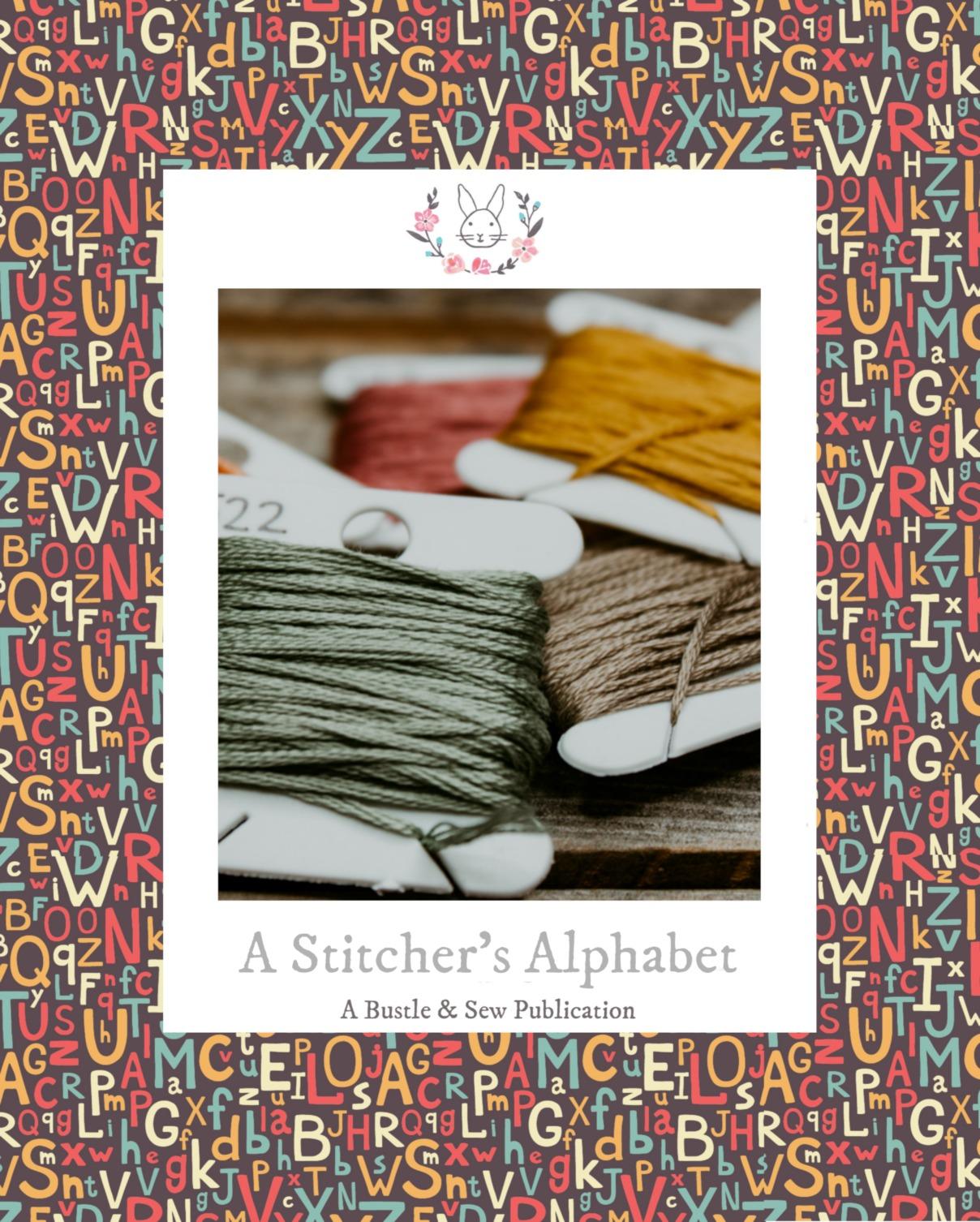
A Bustle & Sew Publication
Copyright © Bustle & Sew Limited 2022
The right of Helen Grimes to be identified as the author of this work has been asserted in accordance with the Copyright, Designs and Patents Act 1988.
All rights reserved. No part of this publication may be reproduced, stored in a retrieval system or transmitted in any form, or by any means, without the prior written permission of the author, nor be otherwise circulated in any form of binding or cover other than that in which it is published and without a similar condition being imposed on the subsequent purchaser.
Every effort has been made to ensure that all the information in this book is accurate. However, due to differing conditions, tools and individual skills, the publisher cannot be responsible for any injuries, losses and other damages that may result from the use of the information in this book.
First published 2023 by: Bustle & Sew Station House West Cranmore Shepton Mallet BA4 4QP www.bustleandsew.com
Introduction
Ihavesewn,knittedandembroideredforalmostallmylife-workingwithfabric andfibrereallyisapassionofmineanditisofcoursehowIearnmylivingthrough mybusiness,Bustle&Sew. SowhenIhadthechancetoputtogetherthisnotquite randomcollectionofstitchingfactsIapproachedthetaskwithrelish,andtheresult isthislittlebookwhichIhopeyou’llfindthislittlebookinteresting-and informativetoo-IknowthatIlearnedlotsofnew,andsometimesratherstrange, factswhileIwascarryingoutmyresearch. Betweenthesecoversyou’llfinditems rangingfromalpacastoDorsetbuttonsandQueenElizabethI,fromquiltingto samplers(viapenelopeclothandreindeerhair,andmuchmorebesides.
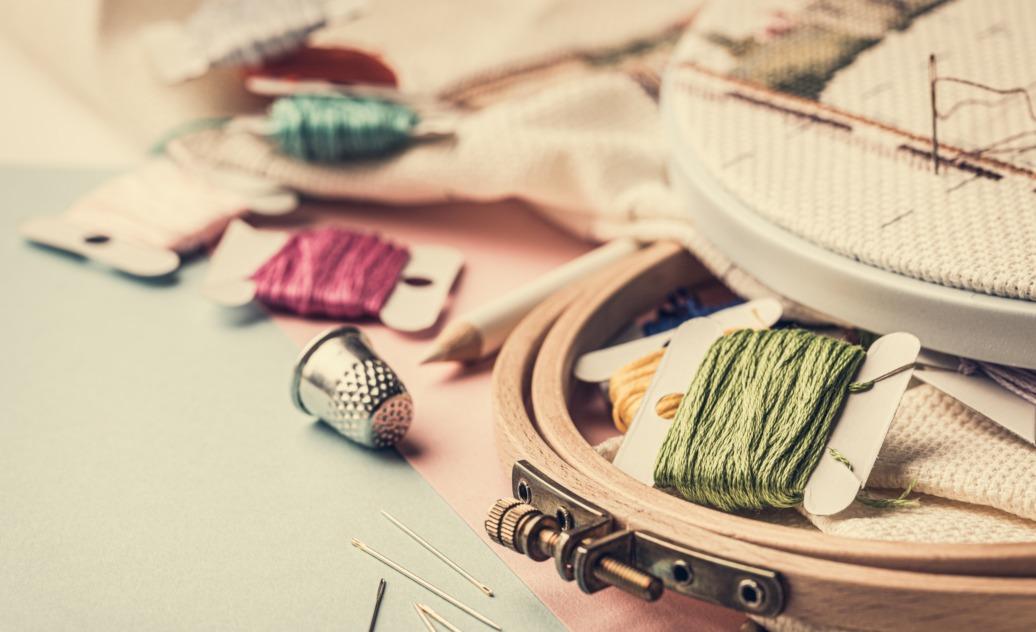
Happyreading!
HelenGrimesJanuary2023
Aloethreadembroidery

Aloe thread embroidery is exactly as described on the packet, in that it is embroidery worked using a thread made from the fibres of the aloe plant.

Based on an account in The Dictionary of Needlework (1882) it would appear that it was worked by “the peasants of Abbissola and the nuns of Oldivales,” who were used to making lace from the fibres of the aloe.
It would appear that at that time they had recently started to embroider with aloe threads instead of silks. The aloe threads had the colour of pale straw and were worked using satin stitch and generally laid over a padding of wool to raise it from the ground material (foundation) of silk or serge cloth.
AmishQuilting
Amish communities spread across Ohio, Indiana, Illinois, Iowa, and the Great Plains in the 19th and 20th centuries, and developed their quilting along the way. Purely decorative objects were forbidden to the Amish, but the cold Midwestern winters meant that quilts were a practical necessity.

Amish women were responsible for quilt-making. The Amish rarely use electricity, so hand-stitching remains the technique of choice. They often work in groups, with relatives or friends. At first, quilts were mostly made for family use but they also became important goods for sale. Amish quilts are known for being hand-made and very high quality.
Amish quilts were sometimes as plain as the usual Amish clothing, using the same dark colours and simple but effective stitching. As time went on, though, Amish women adopted more intricate patterns and techniques and their quilts are beautifully worked in large geometric shapes such as rectangles and stars in muted colour schemes.
Alpaca

The alpaca is a domesticated llama-like animal native to South America and its long soft wool has been spun into yarns for weaving and embroidery for thousands, of years. Fabric woven from alpaca wool mixed with other yarns was first introduced to the UK in the early nineteenth century. Mother alpacas almost always have their babies in the mornings, this is related to life in the high desert in South America where temperatures are very cold at night. By having their babies in the morning, the little ones will have the whole day to dry off, begin walking around, and nursing from the mother before the temperatures begin to drop.
Antimacassar
In 1783, a London barber named Alexander Rowland produced a new conditioner to groom, style, and promote the growth of hair. Made with a mixture of coconut or palm oil and other fragrant oils, the newly patented Rowland’s Macassar Oil became a hugely popular and nationally advertised product.
Having oiled and slick hair was soon the fashion for men (and women) of all ages and backgrounds, a trend that continued into the Victorian era. Unfortunately, the pungent and viscous oil tended to transfer from the back of one’s head onto the upholstery of a chair or sofa and leave behind a stain.
By the 1850s, housewives had a solution: a piece of cloth, easily washable, which they placed over the back of the chair to protect the upholstery beneath. These fabric coverings came to be called antimacassars.
Antimacassars were a staple of the Victorian home. They were typically made by crocheting or tatting patterns into a durable fabric that could be washed and reused. And while the standard colour was white, so as not to clash with the colour of the upholstery underneath, pattern sources suggested they could be made from the odds and ends in different colours. Embroidery was also a way of beautifying these mundane items and many different patterns were available. The level of complexity varied, and displaying beautiful, hand-made antimacassars in the public space of the parlour signified not only a woman’s skill but her abilities as a homemaker. By the 1920s and 30s, antimacassars belonged with crocheted doilies, tea covers, ornamental lacework mats, and other decorative covers whose “fussy” appearance in the home was considered a holdover from the Victorian era. Nonetheless, they were a failsafe domestic occupation for women concerned over having idle hands.
Antimacassars were also used in public transportation. Trains, buses, and aircrafts placed fabric coverings on the seat headrests to extend the life of the upholstery and provide the appearance of sanitation. Linen companies produced these products in bulk, typically adorning plain beige linen with a decorative edging of machine-made cotton lace. Today you’re still likely to encounter plain antimacassars branded with a company logo, but those are a far cry from the lovely and unique objects produced by industrious homemakers over a century ago.

Apron
People across the world have worn aprons at some period, whether as the only covering for modesty purposes, to protect clothing worn beneath or as a decorative costume accessory. Aprons have been worn for work from medieval times when they were made of linen, wool, calico, leather or sacking with little or no decoration.
In the fourteenth century an apron with a bib was known as a barme-cloth and the carpenter’s wife in the from the (Geoffrey Chaucer 1392) is described as wearing “A barme-clooth erk, as whit as morne milke” (barm then meant bust or bosom).
In Europe aprons were at probably their most beautiful in the middle of the eighteenth century, part of the fashion for the aristocratic ladies of France, led by Marie Antoinette to play at being simple rustics, the apron being a symbol of the lower classes. In contrast, in America at that time the apron was very much a working garment and the inventory of Jane Humphries of Massachusetts lists “
Towards the end of the nineteenth century, middle aged and elderly ladies often wore black satin aprons embroidered with brightly coloured silk.
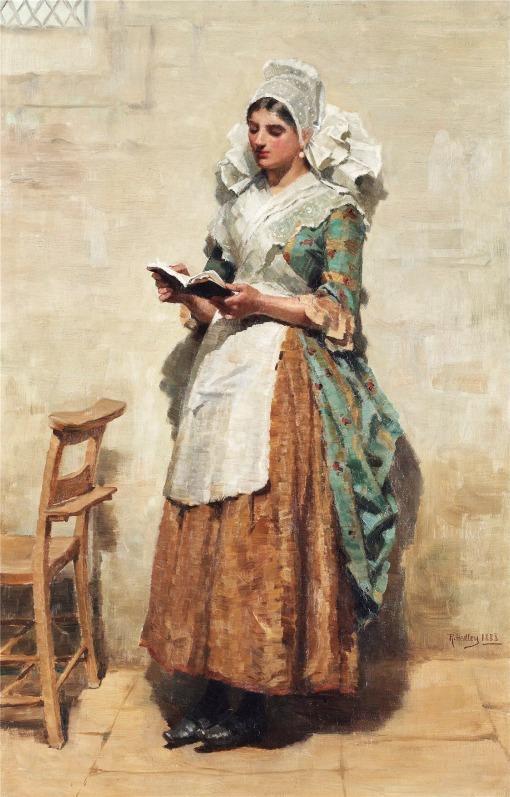
ArtNouveau
Art Nouveau is an ornamental style of art that flourished between about 1890 and 1910 throughout Europe and the United States. It is characterized by its use of a long, sinuous, organic line and was employed most often in architecture, interior design, jewellery and glass design, posters, and illustration. It was a deliberate attempt to create a new style quite different to the fussiness of mid-Victorian style.
The arts and crafts movement at that time (John Ruskin, William Morris and others) turned towards the idea of beautiful objects made from hand in this style and it permeated architecture and every craft including wrought iron work, furniture making, interior design, glassware, jewellery and inevitably embroidery and textiles.
 Woman with apron reading (1888). Ralph Hedley (1851-1913)
Woman with apron reading (1888). Ralph Hedley (1851-1913)
Basting

To baste something is to sew it with a long lose thread to mark out divisions or sometimes to outline the design to be worked. Technically basting is only sewn through one thickness of fabric whilst tacking is sewn through two layers, but certainly in my family and I think probably more widely, the two terms are used interchangeably.
Whether tacking or basting, the stitches are removed when the piece of work is complete.
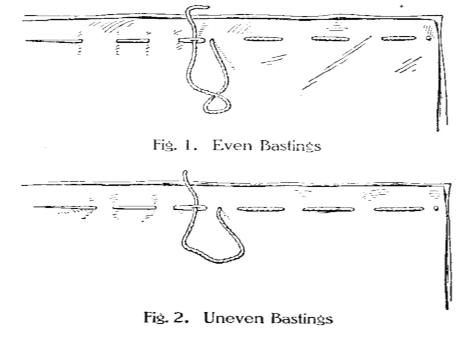
Bedspread
Sometimes known as a counterpane or coverlet this does as it says - it’s a top cover that you spread over your bed for both warmth and decoration - excluding those which are quilted.

The horizontal surface area of a bed provides a large area to be covered by design and bedspreads are amongst some of the most beautiful embroideries. They can be worked in almost any fabric in many different techniques, though the most popular in my own childhood was the candlewick bedspread (shown on the right).
Candlewicking, or candlewick is a form of whitework embroidery that traditionally uses an unbleached cotton thread on a piece of unbleached muslin. It gets its name from the nature of the soft spun cotton thread, which was braided then used to form the wick for candles. Traditionally, candlewick embroidery consists of a series of raised knots used to create an outline that forms a tactile pattern on the fabric, such as a flower, circle or heart.
BerlinWoolwork
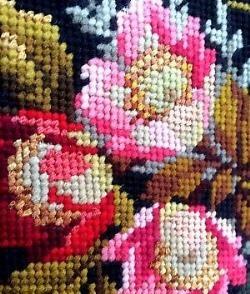
Berlin woolwork evolved from the tent stitch embroideries of the sixteenth - eighteenth centuries. It was worked in Berlin wool - a loose untwisted yarn, available in a large variety of shades that would satisfactorily fill the holes in the canvas. In the early nineteenth century it was produced in Gotha (Germany) and dyed in Berlin, but as the century progressed it began to be manufactured in Yorkshire.
Berlin woolwork was extremely popular in both the UK and US in the mid-nineteenth century and its popularity didn’t begin to decline until art needlework and the Morris movements became fashionable. It wasn’t popular with teachers, artists and magazine editors howeveras the use of thick wool and pre-printed canvases was seen as detrimental to creativity and expertise. In 1886 the Magazine of Art wrote:
It also left in its wake chair coverings, cushions, bell-pulls, carpet slippers, braces, handbags, pictures and anything which fancy or ingenuity could enable its covering with Berlin woolwork!.
German designs for use in Berlin wool work were imported into England, printed on point paper with each square corresponding to a square on the canvas so the design could be read from the chart rather than being drawn directly onto the canvas.
Blackwork
This is a type of embroidery that first became fashionable in England in the sixteenth century and has been revived at intervals since then. Many pieces survive from the early years and it’s clear that the work consisted of embroidery worked on fine linen using various stitches including double running, closed herringbone, stem and many filling stitches.
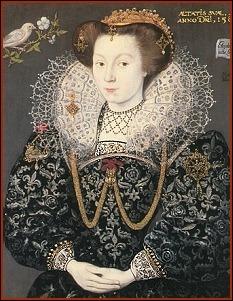
Frequently only black silk thread was used, but sometimes metal thread was added to relieve the black.
Blackwork is Arabic in origin and was very fashionable in Spain in medieval times. Portraits from the sixteenth century show blackwork on shirt collars and cuffs, ruffs and sleeves, making an effective contrast to the bright colours of the silks and other embroideries also worn at that time.
Bodkin
The bodkin may be described as a “short pointed implement.” It may either be a blunt needle with a long eye used for threading cord, tape or ribbon through holes or a casing, or it can be a sharp pointed implement used for making the holes in broderie anglaise (eyelet embroidery) and other work of that kind.
I feel certain that it was the sharp pointed bodkin upon which Sleeping Beauty pricked her finger and slept for a hundred years before being woken by a handsome prince, hence my choice of illustration!
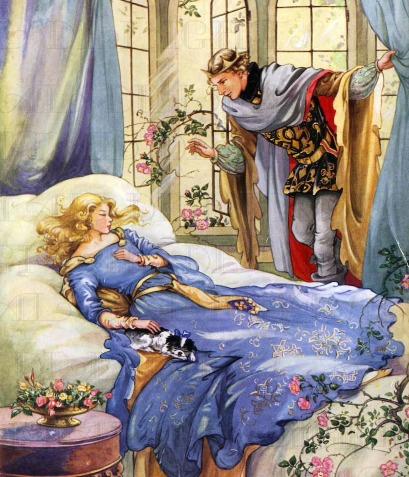
Beeswax
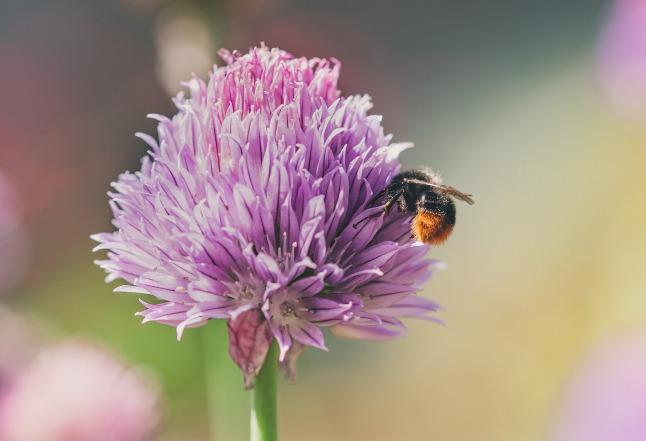
Beeswax can be used for both strengthening and smoothing sewing thread.
Fitted work boxes of the eighteenth and nineteenth centuries often had a space for holding beeswax - which would normally have had an ornamental top with a spike to stick the wax onto and sometimes also a base. Often the edges of the wax were serrated so that the thread could be more easily pulled through it.
BugleBeads
These are small tube-shaped beads, traditionally made from transparent glass. In the nineteenth century however, with its mourning customs, they were frequently made of jet. They were much used on mantles, dresses and accessories from about 1870-1910 and again in the 1920s on the beaded dresses so fashionable for evening wear at the time.
Their history is much longer than this however, bugle work being known from Tudor times and probably earlier. Among the New Year gifts offered to Elizabeth I in 1578 wsa

Canvas
The word canvas was originally used describe a strong cloth made from hemp used primarily for sail-making, but over time the term gradually widened to include a strong unbleached cloth made from jute, hemp or flax and generally tabby woven (see T) which was used for packing goods and as the foundation fabric for large heavy embroideries and household items such as roller towels.
More recently the word has been used to describe a fabric made from wool, cotton, linen, hemp or jute used mainly for embroidering with silk and wool (canvas work, needlepoint, tapestry work and rug making). These canvases are now available in single, double and multiple thread weaves but it wasn’t until the mid-nineteenth century that there was anything other than single thread.
CaribouHairTufting
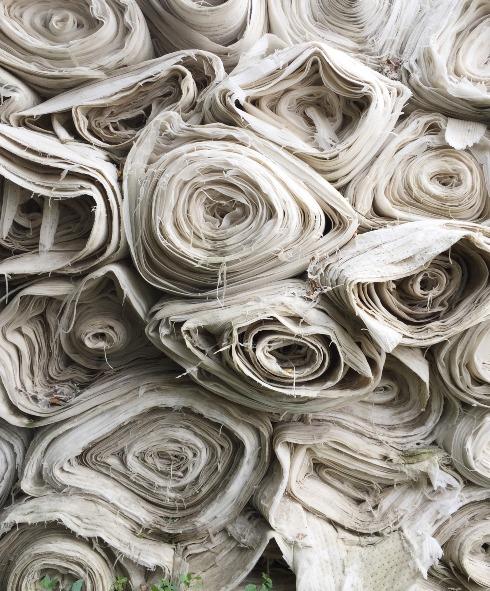
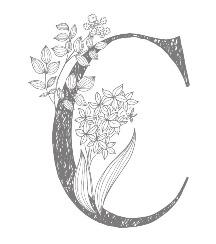
Caribou is the French Canadian word for the wild reindeer of North America. Caribou skin is frequently used for clothing; it is strong, light and very warm due to an air-filled cavity in every hair.
Tufting is an amazing embroidery technique from the far north which takes advantage of these hollow hairs. The hairs for this form of embroidery are taken from the ruff around the animal’s neck and the white spots on both sides of the tail. These are pure white from root to tip and were traditionally used white rather than dyed. The worker uses the hairs to create threedimensional flowers and leaves by tightly pulling small bunches of hair under a loop stitch and fastening it off. The hairs are then fanned out on all sides of the stitch and trimmed into smooth rounded tufts

OK, I’m cheating a bit here, but I needed something for X and after all I haven’t mentioned one of the most popular types of embroidery today yet - that is to say cross (X) stitch.

Cross-stitch is a form of counted-thread embroidery in which cross stitches are used to form a picture. The stitcher counts the threads on a piece of even weave fabric (such as linen) in each direction so that the stitches are of uniform size and appearance. This form of cross-stitch is also called counted cross-stitch in order to distinguish it from other forms of cross-stitch.[ Sometimes cross-stitch is done on designs printed on the fabric (stamped cross-stitch); the stitcher simply stitches over the printed pattern.
Cross-stitch is the oldest form of embroidery and exists all over the world. It was traditionally used to embellish or mark household linens such as tablecloths, sheets or towels. There is a current trend for more postmodern or tonguein-cheek designs featuring retro images or contemporary sayings. It is linked to a concept known as 'subversive cross-stitch', which involves more risque designs, often fusing the traditional sampler style with sayings designed to shock or be incongruous with the oldfashioned image of cross-stitch.
ZariEmbroidery
Zari thread is widely used for weaving, but more selectively in a style of embroidery that came to India from central Asia in the twelfth century. An ornate and sumptuous craft, it was popular with the well off and aristocracy. Zari thread comes in two forms, the dull thread being called Kora; and the shinier one Chikna.
It is believed that the word Zari originated in a village by the same name in ancient Persia (Iran of today) where artisans used the skill of weaving thin threads of gold and silver onto fine fabrics of silk.
Today Zari is not made of real silver & gold, but has polyester or cotton yarn at its core, wrapped in silver/golden metallic yarn. It has now been recognised by the Government of India as one of the most ancient forms of handicraft.

XStitch
Why do we love to stitch? After all you can purchase mass-produced textile items at many high streets stores for very little cost. These days handmade means something special - a unique item created with love, a gift from the heart, not one that can be bought. Hand stitching is also a great way to personalise an item, or perhaps to breathe new life into an old favourite that has seen better days.
Bustle & Sew offers my own unique patterns, designed to appeal to all skill levels and bring out all your natural creativity. And you can keep up to date with all the latest news from Somerset where I live as well as the newest patterns and much more over on the Bustle & Sew Blog.

You might also enjoy our monthly Bustle & Sew Magazine. There's no advertising whatsover, just lots of lovely pages of content celebrating life here in the English countryside - with sewing very much at its heart of course. And here's our guarantee.... if after you've tried our magazine you decide it isn't for you, then all you need to do is drop me a quick email to unsubscribe, there's no tie-in and no penalty at all. If you'd like to continue then you don't need to do anything, your subscription will continue until YOU decide to stop - it's completely up to you.
Just CLICK HERE to visit our subscriptions page to learn more and to try our magazine. Alternatively, if you prefer to shop on Etsy, you can purchase a 12 months subscription from my Etsy shop.
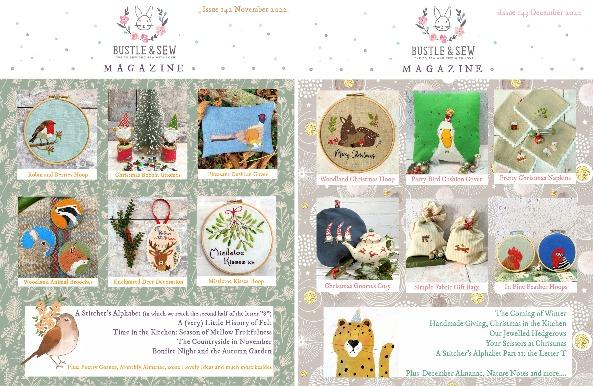



© Bustle & Sew 2023

Helen xx









 Woman with apron reading (1888). Ralph Hedley (1851-1913)
Woman with apron reading (1888). Ralph Hedley (1851-1913)


















